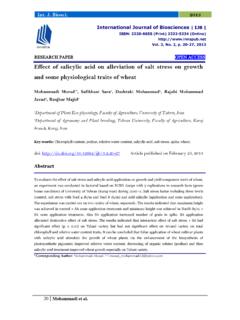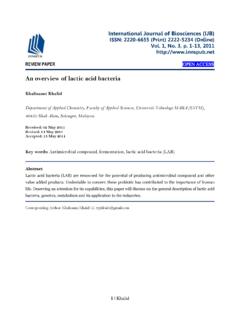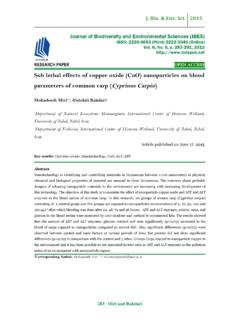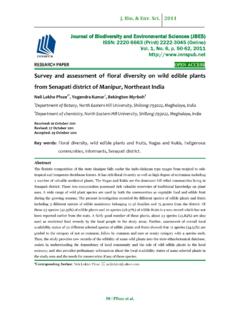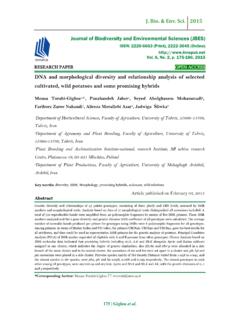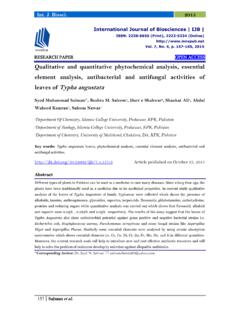Transcription of The effect of plant growth regulators and different …
1 Int. J. Biosci. 2014. International Journal of Biosciences | IJB |. ISSN: 2220-6655 (Print) 2222-5234 (Online). Vol. 5, No. 5, p. 139-146, 2014. RESEARCH PAPER OPEN ACCESS. The effect of plant growth regulators and different types of explants on in vitro regeneration of sweet pepper (Capsicum annuum L.). Neda Pishbin1, Amir Mousavi2*, Sepideh Kalatejari1, Mehran Shariatpanahi3, Behnam Behrooznam Jahromi4. 1. Department of Horticultural Sciences, Science and Research Branch, Islamic Azad University, Tehran, Iran 2. National Institute of Genetic Engineering and Biotechnology (NIGEB), Tehran, Iran 3. Agricultural Biotechnology Research Institute of Iran (ABRII), Karaj, Iran 4. Department of Horticultural Sciences, Jahrom Branch, Islamic Azad University, Jahrom, Iran Key words: Sweet pepper, Regeneration, Hypocotyl, Cotyledon, Cotyledonary petiole.
2 Article published on September 10, 2014. Abstract Present study was conducted to standardize a protocol for in vitro plant regeneration in Capsicum annuum L. cv California Wonder. Three different types of explants (Hypocotyl, Cotyledon and Cotyledonary petiole) from 8- day-old seedling were used. Various concentrations of BA (2, 3 mgL-1), IBA ( , mgL-1) and NAA ( , mgL-1) were used for shoot regeneration. The highest number of shoot per explant was obtained from cotyledonary petiole on a MS medium supplemented with 3 mgL-1 BA and mgL-1 IBA. Effective in vitro shoot elongation was achieved on half strength MS medium containing mgL-1 BA in combination with mgL-1. GA3. As well as adding activated charcoal (3 gL-1) and citric acid along with ascorbic acid caused eliminate phenolic material and prevent shoot necrosis in sweet pepper.
3 Elongated shoots were rooted on half strength MS medium supplemented with 1 mgL-1 IBA. * Corresponding Author: Amir Mousavi 139 Pishbin et al. Int. J. Biosci. 2014. Introduction protocol for the specific cultivars. With this Capsicum annum L. is an economically important background, present investigation has been crop plant cultivated throughout the world (Vema et. undertaken to find out the appropriate explants and al., 2013). It is also gaining importance as an optimal concentration of growth regulators for ornamental plant due to its attractive, colorful and maximum shoot production and establishment of long-lasting fruit which stand erect on the plant complete plantlet of pepper. So, in this study we (Sanatombi and Sharma, 2007; Shreya et. al., 2014). report an efficient in vitro regeneration protocol from The propagation through seeds is restricted by low cotyledonary petiole, cotyledon and hypocotyls germination rate and short span of viability of seeds explants and different concentration of plant growth (Santombi and Sharma, 2006).
4 The price of seeds is regulators in Capsicum annuum L. cv. California very high, so the establishment of plant regeneration Wonder. methods of these cultivars reduces the dependence of nursery plant production and seed price. Moreover, Material and method pepper is highly susceptible to fungal and viral Establishment of aseptic seedling and explants pathogens and these cause considerable damage to preparation the crop. Tissue culture followed by gene transfer Seed of sweet pepper (Capsicum annuum L. cv. could be an easy, efficient and economic means for California Wonder) were obtained from Falat Iran obtaining large number of disease-free. In vitro plant Company. First, seeds were washed with tab water for regeneration of pepper has been achieved via 3-5 min to reduce the level of surface organisms and protoplast, hypocotyl, cotyledons, young leaves and then were surface sterilized by immersion 70%.
5 Direct somatic embryogenesis (Guany and Rao, 1978; ethanol for 50 second and 15 min in NaOCl with Christopher and Rajam, 1996; Dabauza and Pena, shaking, then rinsed 3 times with sterile distilled 2001; Kumar et. al., 2005, Ashrafuzzaman et. al., water. The sterilized seeds were germinated on half- 2006; Sanatombi and Sharma, 2008; Song et. al., strength MS (Murashige and skoog, 1962) basal 2010; Kumar et. al., 2011; Grozeva et. al, 2012 ) and medium with 30 g/L sucrose and 6 g/L agar. All different medium combination (Kumar et. al., 2005; cultures were kept in 16h of light /8h of dark period at Ashrafuzzaman et. al., 2006; Sanatombi and Sharma, 25 1 C. Explants were derived aseptically from 8- 2008). But many of these investigation did not report day-old seedling. Explants used for the experiment satisfactory result in terms of enhanced number of included cotyledonary petiole, cotyledon and shoots because plant regeneration in pepper is hypocotyl.
6 For preparation cotyledonary petiole, severely limited due to the formation of ill-defined cotyledon from 8-day-old seedling were excised 1-2. bud or shoot like structure which either resist mm including the point of attachment to hypocotyls elongation or produce rosette of distorted leaves that and then cotyledon with 1-2 mm hypocotyl segment do not produced normal shoot (Sripichitt et. al., 1987; was cut in to half. Hypocotyl and cotyledon explants Arrollo and Revilla, 1991; Valeva-Montero and (2-3 mm in length) were placed horizontally and Ochoa-Alejo, 1992; Hyde and Phillips, 1996; Franke- cotyledonary petiole were placed vertically in each Duchenne et. al., 1998; Steintz et. al., 1999; Ochoa petri dish containing shoot induction medium. The Alejo and Ramirez- Malagon, 2001). Several inroads abaxial sides of cotyledon explants were placed down aimed to overcome difficult of shoot elongation have in contact of medium.
7 Been examined (Valeva-Montero and Ochoa-Alejo, 1992; Hyde and Phillips, 1996; Franke-Duchenne, Culture media and condition 1998; Husain et. al., 1999; Steintz et. al., 1999; The culture media was adjusted to pH using 1N. Goleganokar and Kantharajah, 2006; Sanatombi and NaOH or 1N HCl before autoclaving at 121 C for 15. Sharma, 2006; Bello-Bello et. al., 2010). Thus, this min. Explants were incubated on 10 cm diameter make it necessary to optimize in vitro propagation petri dish contained 5 segments of explants in contact 140 Pishbin et al. Int. J. Biosci. 2014. with the medium. (1:1) and kept covered with polythene bags having few holes on it. Humidity was gradually decreased by Shoot bud induction increasing size of holes and finally the polythene bags Shoot bud induction was tested on MS basal medium were removed and then plantlets were transplanted to supplemented with different concentrations of BA (2, pots.)
8 3 mgL-1) alone or in combination with NAA ( , mgL-1) or IBA ( , mgL-1) for three weeks Statically analyses (Table1). Culture were incubated in a growth chamber All experiment were set up in a completely in 16h of light /8h of dark period at 25 1 C. randomized design. Data were analyzed by the program SPSS and MSTATC using one-way analyses The medium was refreshed every two weeks and of variances (ANOVA) and the means were compared weekly observation were recorded. The percentage of using Duncan's multiple range test. explants with regenerated shoot buds and number of shoot regenerated per explant were recorded after Results four weeks of cultures. Shoot induction effect of explants type Elongation of shoot buds and rooting Preliminary experiments were conducted to test the The shoots were transferred to shoot elongation effect of various explants such as cotyledonary medium containing half-strength MS medium petiole, cotyledon and hypocotyl on shoot induction.
9 Supplemented with mgL-1 BA alone or in Among the test, bud were producing directly only combination with GA3 and PAA (Table3). Number of from cotyledonary petiole explants ( ) while shoot elongated and shoot length were recorded after other explants formed callus at the cut end of the one month. Some explants placed on culture medium explants, the induction of white or slight green callus released dark colored compound such as phenols and was observed in the wounded explants edges, then other pigments from the cut end of the explants. This adventitious buds were formed ( ). The can cause browning of tissue and medium (Rout et maximum number of shoot/explants was produced in al., 2006). Sub culture of the necrotic shoots on to cotyledonary petiole and shoot induction was found multiplication medium as well as to plant growth higher in hypocotyl than cotyledon (Table 2).
10 Regulator-free medium was not beneficial for recovery Difference in regeneration potential of different of shoots. In order to decrease leaves and shoot tip explants observed in present study is similar to necrosis citric acid (100mgL-1) + ascorbic acid reports Goleganokar and Kantharajah , 2006;. (100mgL-1), activated charcoal (3gL-1), vitamin Elwan , 2009; Suratman et al., 2010; Naderi et al., complex containing biotin (1mgL-1), calcium 2011; Kumar and Tata, 2012; Rizwan et al., 2013. pantothenate ( ) and riboflavin ( mgL-1) +. folic acid ( ) were used (Tabe4). The effect of plant growth regulators elongated shoot were excised transferred to rooting Usually high cytokinine to auxin ratio is beneficial for medium containing mgL-1 IAA or IBA. All bud regeneration (Phillips and Hubstenberger,1985).

